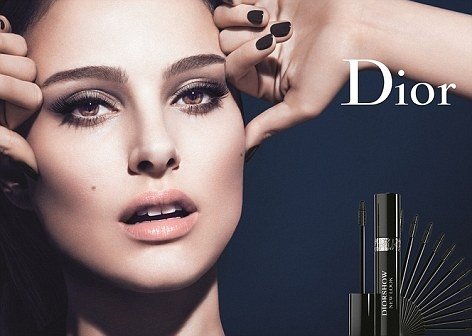
An advert for mascara by Christian Dior starring Natalie Portman has been banned for misleading women into thinking it would give them “lusher lashes”.
The magazine advertisement, showing Natalie Portman staring into the camera with well defined eyelashes, was challenged by rivals L’Oreal who said the photo exaggerated the effects of the mascara.
The ad boasts “the miracle of a nano brush for an unrivaled lash creator effect. It delivers spectacular volume-multiplying effect, lash by lash”.
Dior admitted that the image had been digitally retouched, saying it was done to “increase the length and curve of a number of lashes” as some of the actresses eyelashes were “missing or damaged” in the original photo.
They said that they believed the “retouching” was minimal.
Bosses at the Advertising Standards Authority (ASA), however, banned the ad from being used again, saying it was misleading and exaggerated the effects of the mascara.
This is not the first ad to be barred by the ASA, who act as the UK’s independent regulator of all media.
ASA banned two Channel 4 ads for My Big Fat Gypsy Wedding earlier this month for being offensive, and have previously banned ads by Virgin media, Homebase and Lancome skin care.

They stated about the Dior advert that: “The ASA understood that the digital retouching was intended to separate/increase the length and curve of a number of Natalie Portman’s lashes to replace/fill a number of missing or damaged lashes, to increase the thickness and volume of a number of her natural lashes and, primarily, to stylistically lengthen and curve her lashes.
“We noted that the ad had therefore used post-production retouching on an area – namely the eyelashes – which was directly relevant to the apparent performance of the mascara product being advertised.
“We considered that the ad’s claims <<Lash-multiplying effect volume and care mascara….an unrivalled lash creator effect>> and <<delivers spectacular volume-multiplying effect, lash by lash>>, particularly in conjunction with the image of Natalie Portman’s eyelashes, would be understood to mean that the mascara could lengthen the lashes, as well as separate them, increase their thickness and volume, and generally enhance lash appearance.”
It added: “We had not seen evidence of the product’s effects on Natalie Portman’s lashes where there had not been any post-production retouching and therefore considered we were unable to assess the effects of the post-production work on the image featured in the ad.
“We were concerned that we had not seen evidence that the visual representation of the product’s effects on Natalie Portman’s lashes, as featured in the ad, could be achieved through use of the product only, particularly as we understood that post-production retouching on the lash area had taken place.
“Because we considered that we had not seen sufficient evidence to show that the post-production retouching on Natalie Portman’s lashes in the ad did not exaggerate the likely effects of the product, we concluded the ad was likely to mislead.”
Dior chiefs said it had not received any complaints about the ad from customers and said the ad “did not go beyond the likely consumer expectations of what was achievable with the product”.
They said the advert was a “stylized and aspirational ad intended to convey the luxury image and allure of the Diorshow Mascara” and that “consumers expected images used in ads for beauty products to have used professional styling and photography”.
Dior also said that Natalie Portman’s upper eyelashes were digitally altered, stating: “Digital retouching was nearly exclusively in relation to her upper lashes and was primarily used to separate/increase the length and curve of a number of her lashes and to replace/fill a number of missing or damaged lashes, for a more stylized, uniform and tidy effect.”
It added that eyelashes were “by nature generally fine in appearance and various lashes or elements of lashes could be nearly invisible to the naked eye”.